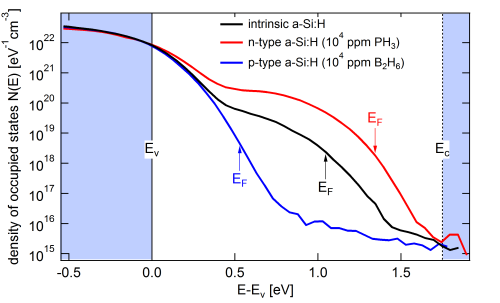Institute Silicon Photovoltaics
Thin amorphous Silicon Films
In order to decrease recombination at the amorphous/crystalline silicon heterojunction and thereby increase solar cell efficiency, it is important to obtain information on the Fermi level position and the distribution of recombination active defects in the band gap of the ultra-thin undoped and doped a-Si:H films which are used in such cells as buffer and emitter-/BSF layers, respectively. Photoelectron spectroscopy with excitation in the near-UV spectral range (NUV-PES) can provide such information, especially in the so-called “Constant Final State“ mode.
Typical NUV-PES measurements on 10nm thin a-Si:H films deposited with varying doping on c-Si wafers are shown in Fig. 1. The origin of the energy axis is set to the valence band edge EV, the density of states was normalized to 2×1021 states/(cm3eV) at this energy.
The density of states distribution in the band gap consists of the so-called Urbach-Tail (linear in the semilogarithmic plot) and a broad Gaussian distribution of "dangling bond"-defects at E-EV~0.4-1.5 eV. It is obvious, that not only the Fermi energy is shifted with doping: the defect density is also increasing (compare the undoped to the n-doped film). This lower defect density in (i)a-Si:H is the reason why undoped buffer layers are advantageous in a-Si:H/c-Si solar cells. Note, that above the Fermi level, the defect states are unoccupied and can thus not be characterized with photoelectron spectroscopy.
For the same reason, the dangling bond defects in the p-doped film are not visible: The defect distribution in this film moves towards the conduction band edge, i.e. is localized mostly above EF and unoccupied, thus not detectable.

Fig. 1: Density of occupied states in 10nm thin a-Si:H films with varying doping, as measured with near-UV photoelectron spectroscopy in the “Constant Final State“ mode and normalized to N(E-EV=0)=2×1021 cm-3 eV-1. EV was obtained by fitting an a-Si:H model density of states to the measured data. Arrows mark the position of the Fermi energies EF.
